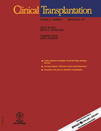De novo membranous nephropathy and antibody-mediated rejection in transplanted kidney
Abstract
Honda K, Horita S, Toki D, Taneda S, Nitta K, Hattori M, Tanabe K, Teraoka S, Oda H, Yamaguchi Y. De novo membranous nephropathy and antibody-mediated rejection in transplanted kidney.Clin Transplant 2011: 25: 191–200. © 2010 John Wiley & Sons A/S.
Abstract: Background: The etiology of de novo membranous nephropathy (MN) after kidney transplantation is still uncertain. Immunological response to various allograft antigens is speculated to be a candidate for the etiology.
Methods: Seventeen patients with post-transplant de novo MN were studied clinically and pathologically in comparison with control post-transplant patients without MN. Double immunofluorescent staining was performed to identify the presence of donor-specific human leukocyte antigen (HLA) combined with IgG in the deposits on glomerular capillary walls.
Results: De novo MN occurs in relatively late period after transplantation (102.1 ± 68.3 months), presenting various degree of proteinuria. Histological findings associated with antibody-mediated rejection (AMR), such as peritubular capillaritis and C4d deposition in peritubular capillary, were more frequently observed in the patients with de novo MN than the non-MN control patients. Donor-specific antibody (DSA) was detected in five patients at the time of biopsy. In one case of de novo MN with DSA, a donor-derived HLA was identified in the subepithelial deposits on the glomerular capillary walls combined with IgG deposition.
Conclusions: DSA and AMR might play some roles for the pathogenesis in some patients with de novo MN after kidney transplantation.




